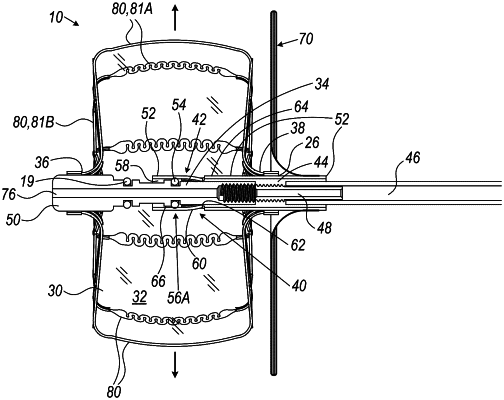| CPC A61B 17/12122 (2013.01) [A61B 17/12136 (2013.01); A61B 2017/00619 (2013.01); A61B 2017/00632 (2013.01); A61B 2017/00853 (2013.01); A61B 2017/12095 (2013.01)] | 19 Claims |

|
1. An occlusion device for occluding a left atrial appendage (LAA), the occlusion device for use with a delivery system, the occlusion device comprising:
a compliant balloon defining a fluid-tight balloon chamber;
an actuating shaft, which is (a) disposed at least partially within the balloon chamber, (b) connected to a distal end portion of the balloon, and (c) longitudinally moveable with respect to a proximal end portion of the balloon so as to set a distance between the distal and the proximal end portions of the balloon;
a proximal LAA-orifice cover, which (a) is configured to assume a radially-compressed state and a radially-expanded state, (b) comprises a frame and a covering fixed to the frame, and (c) when in the radially-expanded state, is generally orthogonal to the actuating shaft and has a greatest dimension, measured perpendicular to the actuating shaft, of between 10 and 50 mm;
an orifice-support stent, which (a) is fixed to and extends distally from the proximal LAA-orifice cover, (b) is configured to assume a radially-compressed state and a radially-expanded state, and (c) is generally cylindrical when in the radially-expanded state;
a valve; and
a locking mechanism, which is configured to assume locked and unlocked states, and which is configured, when in the locked state, to maintain, between the distal end portion of the balloon and the proximal end portion of the balloon, the distance set using the actuating shaft,
wherein the occlusion device is shaped so as to define a fluid flow path along a portion of the actuating shaft,
wherein the valve is configured to selectively allow or block fluid flow between the fluid flow path and the balloon chamber when the valve is in open and closed states, respectively, and
wherein the occlusion device is configured such that reduction of the distance, by proximal longitudinal movement of the actuating shaft:
(a) to a first predetermined distance between the distal and the proximal end portions of the balloon automatically transitions the valve from the open state to the closed state, and
(b) to a second predetermined distance between the distal and the proximal end portions of the balloon automatically transitions the locking mechanism from the unlocked state to the locked state.
|